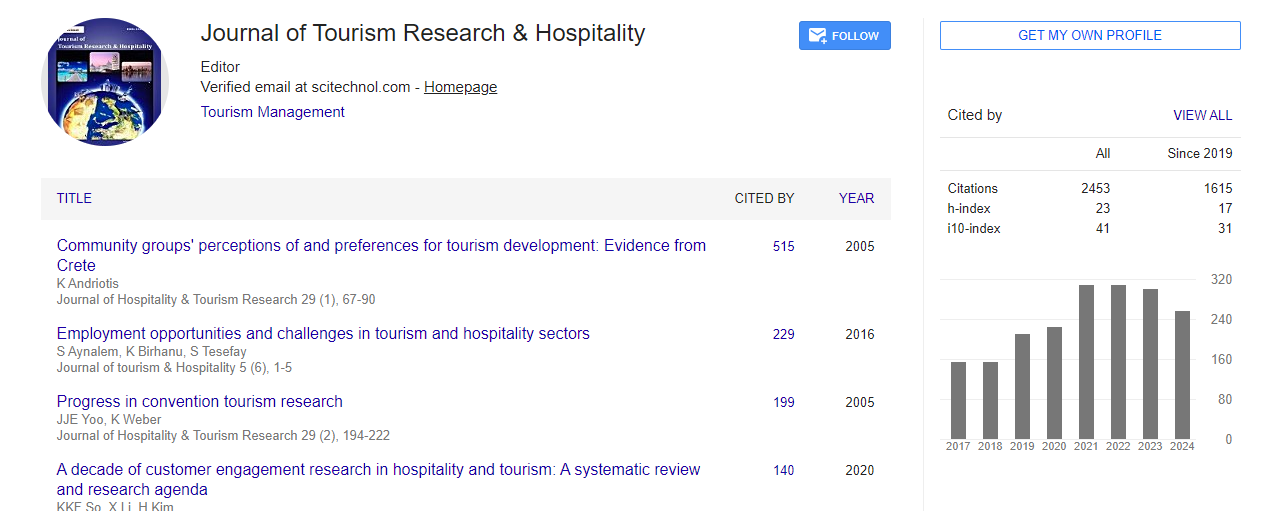Perspective, J Tourism Res Hospitality Vol: 13 Issue: 3
Tourism Impact: The Role of Data Research in Destination Development
Hyunsu Kim*
1Department of Tourism, Guilin University of Technology, Guilin, China
*Corresponding Author: Hyunsu Kim,
Department of Tourism, Guilin University of
Technology, Guilin, China
E-mail: hyunsukim@gmail.com
Received date: 24 May, 2024, Manuscript No. JTRH-24-143389;
Editor assigned date: 27 May, 2024, PreQC No. JTRH-24-143389 (PQ);
Reviewed date: 14 June, 2024, QC No. JTRH-24-143389;
Revised date: 21 June, 2024, Manuscript No. JTRH-24-143389 (R);
Published date: 28 June, 2024, DOI: 10.4172/2324-9110.1000184.
Citation: Kim H (2024) Tourism Impact: The Role of Data Research in Destination Development. J Tourism Res Hospitality 13:3.
Description
Tourism analytics and research are essential components of effective tourism management and development. In an industry characterized by constant change and diverse influences, leveraging data-driven insights helps stakeholders make informed decisions, enhance visitor experiences, and foster sustainable development. This study explains the significance of tourism analytics and research, key methodologies, applications, and the impact of data on shaping the future of tourism. Tourism analytics provide stakeholders with the data needed to make strategic decisions. This includes understanding visitor demographics, preferences, and behaviours. By analyzing trends and patterns, tourism organizations can tailor their offerings, optimize marketing strategies, and allocate resources more effectively.
Analytics plays an essential role in promoting sustainable tourism. By monitoring and evaluating the impact of tourism on local communities, environments, and economies, stakeholders can develop strategies to minimize negative effects and promote responsible tourism practices. This includes managing visitor flows, preserving cultural heritage, and supporting local economies. In a competitive tourism market, data-driven insights provide a significant edge. Destinations and businesses that effectively utilize analytics can better understand market trends, predict future demand, and respond proactively to changes. This competitive advantage is vital for attracting and retaining visitors.
Geographic Information Systems (GIS)
Geographic Information Systems (GIS) technology allows for the spatial analysis of tourism data. By mapping visitor flows, attraction popularity, and infrastructure usage, GIS helps in understanding geographic patterns and planning for better resource allocation and infrastructure development. Descriptive analytics involves summarizing historical data to identify trends and patterns. This includes analyzing visitor numbers, length of stay, and spending behavior. Descriptive analytics provides a foundation for understanding past performance and setting benchmarks. Predictive analytics uses historical data to forecast future trends and behaviours. Techniques such as regression analysis and machine learning algorithms algorithms help in predicting visitor demand, identifying potential market segments, and planning for future growth. Prescriptive analytics recommends actions based on data analysis. It involves using optimization techniques and simulations to determine the best strategies for achieving desired outcomes. Analytics enable targeted marketing by identifying key customer segments and their preferences. By understanding demographic data and behavioural patterns, tourism organizations can tailor their marketing messages and promotions to specific audiences, increasing the effectiveness of their campaigns.
Campaign performance measurement
Tracking the performance of marketing campaigns through analytics helps in evaluating their success and Return On Investment (ROI). Metrics such as click-through rates, conversion rates, and social media engagement provide insights into campaign effectiveness and areas for adjustment. Data on visitor flows helps in managing and distributing tourist traffic to avoid congestion and overcrowding. By analyzing peak times and popular attractions, destinations can implement measures such as timed entry, capacity limits, and alternative routes to enhance the visitor experience. Tourism analytics assess the economic impact of tourism on local economies. This includes measuring the contribution of tourism to GDP, employment, and local business revenue. Economic impact assessments help in understanding the benefits of tourism and justifying investments in the sector.
Future of tourism analytics
The future of tourism analytics will be shaped by advancements in technologies such as Artificial Intelligence (AI), Machine Learning (ML), and big data analytics. These technologies will enable more sophisticated analysis, real-time insights, and personalized experiences for visitors. Real-time data collection and analysis will become increasingly important in managing dynamic tourism environments. Technologies such as IoT sensors and mobile applications will provide immediate insights into visitor behavior, enabling quick responses to changing conditions. As data analytics evolves, tourism organizations will be able to offer even more personalized experiences. By leveraging detailed insights into individual preferences and behaviors, destinations and businesses can tailor their offerings to meet the specific needs and desires of each visitor.
Conclusion
Tourism analytics and research are vital for understanding and shaping the tourism industry. By leveraging data-driven insights, stakeholders can enhance visitor experiences, promote sustainable development, and make informed decisions. Key methodologies such as surveys, social media analytics, and GIS, along with advanced data analysis techniques, provide valuable information for managing and developing tourism effectively. As the industry evolves, the integration of advanced technologies and real-time data will further enhance the capabilities of tourism analytics. Addressing challenges such as data privacy, quality, and integration will be essential for ensuring the continued success and sustainability of tourism.
 Spanish
Spanish  Chinese
Chinese  Russian
Russian  German
German  French
French  Japanese
Japanese  Portuguese
Portuguese  Hindi
Hindi 

